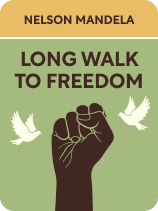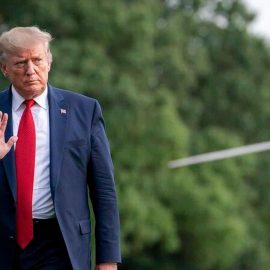

This article is an excerpt from the Shortform book guide to "Long Walk to Freedom" by Nelson Mandela. Shortform has the world's best summaries and analyses of books you should be reading.
Like this article? Sign up for a free trial here.
How long was Nelson Mandela in prison? How does he recall the experience? Why did he refuse to be released in 1985?
Nelson Mandela was sentenced to life behind bars in 1964. He spent 27 years in three prisons. In his autobiography, Long Walk to Freedom, Mandela describes what life was like and shows how prison bars couldn’t stop him in his fight against apartheid.
Read more to learn about Nelson Mandela’s imprisonment and ultimate release.
Robben Island Prison: 1964-1982
For the first 18 years of Nelson Mandela’s imprisonment, he was held in a brutal facility called Robben Island Prison. Mandela notes that most inmates at Robben Island had no beds nor plumbing, and they spent their days doing hard manual labor. Furthermore, prisoners were almost completely isolated from the outside world—not even allowed visits from their families—and they were frequently forced into solitary confinement for minor infractions.
While enduring these harsh conditions, Mandela had to stay alert for attempts on his life. For example, a prison warden once offered to help him escape, but Mandela refused. He later learned that the warden was a plant from the Bureau of State Security, and he would have made sure that Mandela died during the “escape attempt.”
Mandela notes that, at Robben Island, the prisoners engaged in numerous protests against the prison’s inhumane conditions and practices. Most commonly, they went on hunger strikes. However, those strikes were frequently unsuccessful because they only worked if word about the protest spread outside the prison—otherwise, the inmates would simply starve themselves to death while the guards and wardens watched.
Mandela says that he advocated for more disruptive forms of protest, such as refusing to work or refusing to clean. However, he was often outvoted, and he always supported the group’s decisions once they were made.
Pollsmoor Prison: 1982-1988
In 1982, the authorities moved Mandela to Pollsmoor Maximum Security Prison, located near Cape Town. Mandela isn’t sure why he was moved out of Robben Island, though he suspects that the government was trying to undercut the resistance thereby removing its leadership.
Mandela says that, compared to his previous situation, Pollsmoor seemed luxurious. He had to share a room with three other political prisoners—but that room was large, clean, furnished, and had indoor plumbing. Furthermore, prisoners at Pollsmoor got much better food, had a wider selection of reading materials, and were allowed visitors much more frequently than at Robben Island. Even so, it was still a prison.
(Shortform note: Contrary to the relatively nice conditions Mandela described at Pollsmoor, most of the prison is dirty, severely overcrowded, and lacking in basic amenities like hot water; it’s very similar to what Mandela experienced at Robben Island. Many prisons such as Pollsmoor—apartheid-era facilities that were designed to break Black prisoners’ spirits—still exist today, with their inhumane practices and conditions largely unchanged.)
In 1985, prison authorities moved Mandela to a solitary room. Though he regretted being separated from his compatriots, Mandela took advantage of his isolation to start writing letters to the government, trying to arrange a meeting between the ANC and the NP.
According to Mandela, this was a bold step and one he couldn’t have taken while he was with the other prisoners—asking for negotiations might have looked like a sign of weakness or even surrender. However, Mandela believed there was no hope of defeating the NP in a civil war and no sense in wasting more lives trying. Therefore, he decided that he would be the first to reach out and try to find a peaceful resolution to the conflict.
(Shortform note: By pushing for talks with the National Party, Mandela was challenging assumptions about their motivations. This is a crucial step in any negotiation—if both parties think they already know what the other wants and are unwilling to give it to them, then the negotiation can’t proceed. In this case, Mandela and his colleagues assumed that the NP would have no interest in diplomacy. However, as it turned out, the NP was under immense political and economic pressure to end apartheid; as a result, party leaders eventually did start taking steps toward reconciliation.)
A Conditional Offer of Freedom
Mandela notes that, even while he was in prison, his name and message continued to spread. Resistance—much of it violent—built against the National Party as more and more South Africans joined Mandela’s cause.
That’s why, in 1985, State President P. W. Botha offered to release Mandela from prison if he publicly denounced the ongoing violence against the government. Mandela refused, saying that the National Party itself was responsible for that violence. The government held the power—therefore, the government chose whether issues would be resolved peacefully or not.
(Shortform note: This was not the only time that President Botha offered terms for freeing Mandela. For example, in 1986, Botha attempted to negotiate the release of several hostages, with Mandela’s freedom as part of his offer. However, the ANC rejected Botha’s offer out of hand—the group demanded that Mandela be freed without conditions, not simply as a political bargaining chip. This showed that the ANC and the South African people were indeed still fighting against the National Party; there was no room for compromise or deals with their oppressors.)
Victor Verster Prison: 1988-1990
Mandela recalls that, in 1988, he contracted tuberculosis. He was taken to a hospital for treatment. Once he’d recovered, instead of returning to Pollsmoor, he was moved to a nearby facility called Victor Verster Prison.
Mandela says that Victor Verster Prison was much more comfortable than even Pollsmoor. He had a cottage and the surrounding land all to himself; he could do as he pleased. In fact, Mandela says that the cottage felt deceptively “free.”
In July of 1989, Mandela’s efforts to arrange a meeting between ANC and NP leaders paid off, and he had a brief meeting with State President Botha. It was the first time that party leaders had come together for peaceful talks.
As it turned out, that meeting would be the only time that Mandela spoke to Botha as state president—Botha had suffered a stroke in February of 1989, and he stepped down from the presidency in August of that same year.
Mandela’s Freedom
Mandela explains that Frederik Willem de Klerk, commonly known as F. W. de Klerk, became state president after Botha resigned. At De Klerk’s order, Nelson Mandela was finally released from Victor Verster Prison on February 11, 1990.

———End of Preview———
Like what you just read? Read the rest of the world's best book summary and analysis of Nelson Mandela's "Long Walk to Freedom" at Shortform.
Here's what you'll find in our full Long Walk to Freedom summary:
- Nelson Mandela’s extraordinary life story, as told by the man himself
- Why it took Mandela over 40 years to finish his law degree
- Nelson Mandela’s legacy and what South Africa is like in its post-apartheid years






